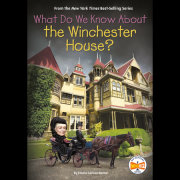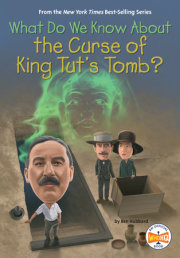What Do We Know About the Winchester House? In the spring of 1886, a well-dressed woman rolled into the Santa Clara Valley, California, in her carriage. Her name was Sarah Winchester. She was a widow, and she was very rich. She had moved from New Haven, Connecticut, on the East Coast, and she wanted warm weather, peace and quiet, and lots of space.
Sarah, who was nearly fifty years old, moved into an eight-room farmhouse on forty-five acres that she called Llanada (ya-NAH-dah) Villa—Spanish for “the house on the plain.” Almost right away, she began building. In the first six months after she moved in, the house grew to twenty-six rooms!
The ambitious woman never really stopped building. Over the next thirty-six years, Llanada Villa, later known as Winchester House, grew from eight rooms to a hundred and sixty rooms. Spreading over six acres, the size of more than six football fields, the enormous house eventually had six kitchens, two thousand doors, thirteen bathrooms, forty-seven staircases, and ten thousand windows!
No plans were drawn, and no architects had been hired. Sarah ordered her builders to add rooms wherever she wanted them, and if she didn’t like how the room looked, she would order them to tear it down. Then she would ask them to start over.
Sarah loved her house. She decorated it with expensive wood floors and paneling made of rare teak, mahogany, and rosewood. The sunlight streamed through elaborate stained glass windows. Flowered tiles surrounded the fireplaces, and very expensive wallpaper covered the walls. Llanada Villa was a beautiful home.
Llanada Villa is now called Winchester House. And it is still quite beautiful. But visitors to the home today find that it is also very odd. One stairway goes up seven steps. Then it goes down eleven. One doorway opens out into midair. Take an extra step, and you’ll plummet into a kitchen eight feet below! The rooms and hallways twist and turn like a maze. Anyone could get lost.
Why did Sarah build her house so strangely? Why are there so many things numbering thirteen in the house—thirteen bathrooms, thirteen holes in a sink drain, and thirteen windows in the thirteenth bathroom? And thirteen gas jets on the grand chandelier in the ballroom!
Why are there so many hidden passageways and odd openings to look through?
Llanada Villa started as a simple farmhouse. Sarah Winchester built it into a massive, confusing mansion. Over time, stories grew and grew about
why her house looked the way it did. Was the house haunted by spirts? Did Sarah Winchester invite those spirits into her home? Today, people are still asking those questions. Visitors can take tours and wander the bewildering rooms that Sarah Winchester built at Llanada Villa. Will they meet spirits and ghosts as well? Some say they have. Others say the mysterious house is simply misunderstood and perhaps not quite haunted. But no one can know for sure.
Chapter 1: Life in New Haven Sarah Pardee Winchester was not the first Sarah in her family. She was the third. Her mother was named Sarah. And eight years before Sarah Winchester’s birth in 1839, a different Sarah had been born. She was the first child of Leonard and Sarah Pardee. This little Sarah died when she was only eighteen months old.
The Pardees had two more daughters, Mary and Nettie, and a son named Leonard after his father. By the time their third daughter was born, they were ready for another Sarah.
Sarah was born in a pretty, tree-filled neighborhood of New Haven, Connecticut, where her family had lived for generations. They were kind, educated people. Sarah’s father was a carpenter. Her mother took care of the house and the children. But when a fire in 1837 destroyed part of the city, Leonard’s carpentry business was destroyed as well. Some people in New Haven had lost everything, so they did not have money to pay a carpenter, even though there was plenty of rebuilding to be done. Instead, Leonard took a job watching over the public baths—a place where people who didn’t have private bathrooms could wash—in New Haven. The family lived in their own rooms there, like a private apartment.
A few years after the fire, Leonard started working as a carpenter again. When Sarah was around seven or eight, Leonard set up a full-time carpenter’s shop. Sarah grew up surrounded by planks and pieces of wood, paint, axes, planes, and saws. She watched her father and his helpers craft pedals for pianos, hitching posts for horses, doors, and window frames. Her interest in building and woodworking grew. Later, she would put all this knowledge to use when building her own home.
By the early 1850s, when Sarah was a young teenager, the family was starting to recover from their setbacks due to the New Haven fire. Leonard made good money as a carpenter, and the Pardees moved to a big house in a nice neighborhood. Leonard expanded his carpentry shop, and the family grew wealthier. The Pardees were now well-known and respected in New Haven. Sarah was taught by a private French tutor and took music lessons. She dressed in fancy clothes. She was shy but lively.
But Sarah wouldn’t stay home forever. At the time, women were expected to get married and move out of their parents’ homes. When she was in her early twenties, Sarah began dating William Winchester. She’d known him for many years—the Pardees and the Winchesters had been next-door neighbors. Their families went to the same church, and Sarah’s father helped fix the machines at William’s father’s shirt factory. Sarah had grown up with William. Now he was getting ready to work for his father at his family’s huge shirt factory and mill. William would one day be a rich man.
At this time, the United States was edging closer and closer to civil war. And on April 12, 1861, Confederate soldiers attacked Fort Sumter in South Carolina. When war broke out, Sarah’s brother was one of the first to volunteer to fight. He left New Haven on April 21, 1861, and he joined the Second Connecticut Infantry. About a year later, Sarah and William married in a quiet ceremony.
Sarah’s brother fought in the First Battle of Bull Run in Manassas, Virginia, one of the first major battles of the war. Under the hot July sun, the Union troops fought fiercely but, in the end, could not defeat the Confederates there. He returned home after Bull Run. He had been in the army for three months. His family breathed a sigh of relief that he was safe. Sarah’s sister’s husband, Homer, fought for four years in the Union Army and also came home safely.
As the war drew to a close, life seemed good for Sarah and her family. Their loved ones had survived the fighting. Sarah and William had a lovely home with his parents and plenty of money. The Union had won the war. The Winchesters must have surely believed the worst times were now behind them. But they were wrong.
Chapter 2: Tragedy Strikes William Winchester’s family was very wealthy. Their shirt factory, the Winchester & Davies Shirt Manufactory, was successful. But before the Civil War, William’s father, Oliver, had also invested money in another company, one that manufactured guns. The Volcanic Repeating Arms Company made a type of gun called the “Winchester repeater,” and it was very popular.
It made the Winchester family lots of money. Sarah would be wealthy for the rest of her life.
In 1865, Sarah learned that she was pregnant. Everyone was excited, especially William. He and Sarah couldn’t wait to be parents.
Baby Annie was born on June 15, 1866, when Sarah was twenty-seven years old. Sarah had her daughter at home, like most women at that time. She was a healthy baby, and her parents adored her.
But as the days went by, Sarah and William realized that something was wrong with the baby. She wasn’t eating. She couldn’t seem to digest her milk, and she was losing weight, fast. Sarah was frantic. She had waited three years for a child, and now her daughter seemed to be fading in front of her eyes. They called in a special nurse to feed Annie. A doctor came. But he couldn’t do anything for the sick baby. Annie cried and cried, night and day. She was starving to death, and the doctor said the baby had a disease that might be keeping her from digesting food.
Baby Annie died at only five weeks old, on July 25. Her tiny body was buried at the family cemetery. William and Sarah would never have another child.
Sarah and William tried to recover from the death of their baby by working on their plans for a huge mansion they were building in New Haven that they would share with William’s parents. This giant house would have marble floors, chandeliers, and floor-to-ceiling windows. Both William and Sarah threw themselves into the work of going over the architect’s plans, supervising the workmen, and choosing the stone, wood, and wallpaper for the rooms inside. Sarah loved it all. Building construction and designing houses were her passions, and they were good distractions from her heartbreak. They moved into the house in 1868.
William and Sarah were happy in their new house. They loved it, and they loved each other. William worked as the secretary for the family gun company. Sometimes, William and Sarah went with William’s father, Oliver, on business trips. They most likely had friends and family over to their house for dinners and parties.
But William was sick. For a long time, he had been weak and coughing. The cold, snowy winters of the Northeast made him cough even more. He had tuberculosis, a disease caused by bacteria that infect a person’s lungs. There was no cure. William grew weaker and weaker. Finally, on March 7, 1881, William died.
Sarah was overcome with grief. She dressed in black and draped a heavy black lace veil over her head. She was only a little more than forty years old, but she would never remarry, and she would never forget William.
Sarah wanted a fresh start. New Haven was too full of sad memories. And Sarah already had arthritis in her hands and other joints. The cold of Connecticut made the aching worse. She had inherited William’s part of the Winchester Repeating Arms Company, and now she was one of the richest women in New England. She had enough money to move wherever she chose to.
Sarah traveled to the beach to rest, and then she went to Europe. But she wasn’t happy coming and going. She was also no longer content with her home in New Haven. She wanted something completely different. She wanted a life that was all her own, away from the Winchester family.
Sarah and William had once traveled to California on business for the Winchester rifle company. She liked the sunshine and the warm, clear weather. Sarah made up her mind. In 1885, she packed up and set out for the Santa Clara Valley. She was going to find a piece of land and do what she loved best: build a house.
Copyright © 2023 by Penguin Random House LLC. All rights reserved. No part of this excerpt may be reproduced or reprinted without permission in writing from the publisher.


















































































































